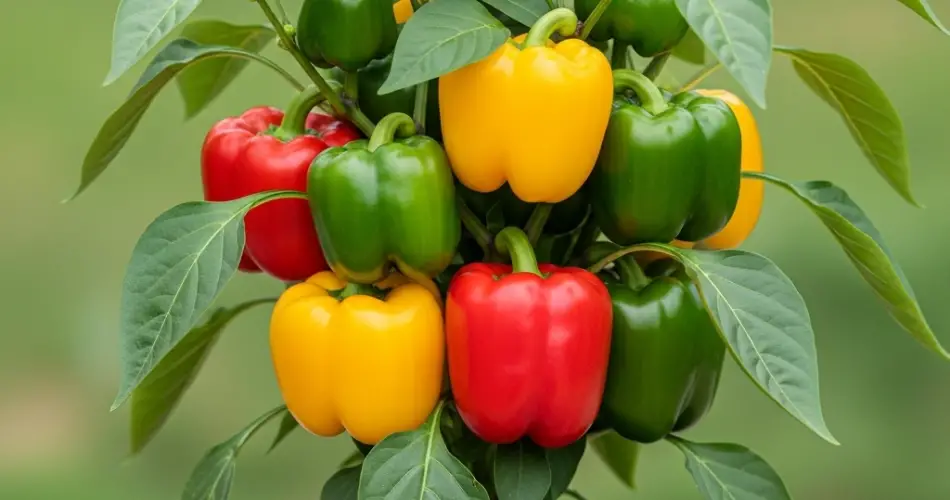Growing peppers in containers is a practical and rewarding way to produce crisp, colorful, and flavorful fruits even without a garden. Whether you’re working with a balcony, rooftop, patio, or sunny porch, peppers adapt well to pots and reward minimal care with continuous harvests. Sweet or spicy, bell or chili—container-grown peppers offer variety, beauty, and taste right outside your door.
Here’s how to grow healthy, productive pepper plants in containers, no backyard needed.
Choosing the Right Pepper Varieties
Not all peppers grow the same. Some varieties perform better in containers due to their compact size and manageable root systems. Ideal container varieties include:
-
Sweet Bell Peppers – ‘Mini Bell,’ ‘California Wonder,’ ‘King of the North’
-
Chili Peppers – ‘Jalapeño,’ ‘Cayenne,’ ‘Serrano,’ ‘Thai Hot’
-
Snack and Ornamental Peppers – ‘Lunchbox Mix,’ ‘Purple Beauty,’ ‘Black Pearl’
Compact and dwarf varieties are especially good for small spaces, but even larger types can succeed in pots with proper support and care.
Best Containers for Peppers
Peppers like warmth and consistent moisture, which makes container selection important.
Container Requirements:
-
Size: Minimum 3–5 gallons (12–20 liters) per plant
-
Depth: At least 12 inches
-
Drainage: Essential; choose pots with multiple holes at the base
Plastic pots retain moisture well, while fabric grow bags allow excellent drainage and air pruning. Choose light-colored pots in hot climates to avoid overheating roots.
Ideal Soil Mix
Peppers require fertile, well-draining soil that retains moisture but doesn’t become soggy.
Create a balanced potting mix using:
-
1 part high-quality potting soil
-
1 part compost or well-rotted manure
-
A handful of perlite or coarse sand for aeration
-
Optional: a tablespoon of slow-release vegetable fertilizer
Avoid using garden soil alone—it may compact and lack nutrients needed for potted plants.
Planting Peppers in Pots
-
Start Indoors (if using seeds): Begin 8–10 weeks before the last frost. Transplant into containers once nighttime temperatures stay above 13°C (55°F).
-
Transplant Seedlings: Choose strong seedlings with at least 5–6 true leaves.
-
Plant Depth: Bury them up to their first set of leaves to encourage root growth.
-
Spacing: One plant per 5-gallon pot, or two in a large rectangular planter.
Water after transplanting and keep the soil evenly moist to reduce shock.
Sunlight and Temperature Needs
Peppers are heat-loving plants. They need:
-
6 to 8 hours of direct sunlight daily
-
Warm soil: At least 18°C (65°F) for healthy root activity
-
Night temps above 13°C (55°F) for consistent fruiting
Place containers where they receive full sun—south-facing balconies, patios, or near reflective walls that trap heat work best. In cooler regions, consider using black pots to keep roots warm.
Watering and Feeding
Container-grown peppers dry out faster than those in the ground. Regular watering and feeding are crucial.
-
Watering: Keep soil moist but never soggy. In warm weather, this may mean watering daily.
-
Feeding: Use a balanced liquid fertilizer every two weeks or a slow-release fertilizer every 4–6 weeks. Look for formulas high in phosphorus and potassium once fruiting begins.
Avoid high nitrogen fertilizers, which encourage leafy growth but few peppers.
Supporting Pepper Plants
As peppers grow and set fruit, their stems can bend or break under the weight.
-
Stake or cage each plant early to provide support.
-
Use bamboo sticks, tomato cages, or simple trellises tied with soft twine or clips.
-
Regularly check for leaning plants and adjust supports as needed.
Pollination and Fruit Set
On balconies or indoors, wind and pollinators may be limited. To encourage fruiting:
-
Gently shake plants to mimic wind
-
Use a soft brush or your finger to transfer pollen between flowers
-
Keep humidity moderate (40–60%) to aid pollen release
Proper pollination leads to more fruits and consistent harvests.
Pests and Problems
Common issues for container peppers include:
-
Aphids or spider mites: Wash off with a strong water spray or use neem oil.
-
Blossom drop: Caused by temperature swings or inconsistent watering.
-
Yellow leaves: Often due to overwatering or lack of nutrients.
Inspect plants regularly and act early to control pests and correct care habits.
Harvesting Your Peppers
Peppers are ready to pick when they reach full size and color. Depending on the variety, this may be green, red, yellow, orange, or even purple.
-
Use scissors or pruning shears to snip peppers cleanly from the plant.
-
Regular harvesting encourages continued flowering and fruiting.
-
Store harvested peppers in a cool, dry spot or refrigerate for longer shelf life.
Final Tips for Pepper Success
-
Rotate container positions weekly to ensure even sunlight exposure.
-
Add mulch (like straw or shredded leaves) on top of the soil to conserve moisture.
-
Keep containers slightly elevated to allow airflow underneath and prevent root rot.
Growing peppers in containers is simple, satisfying, and space-efficient. With the right care and attention, even the smallest balcony can become a vibrant, pepper-producing garden throughout the season.



